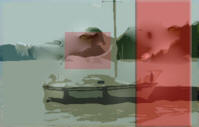 |
 |
| www.BananaWind.us |
When you take up a pastime, you need to know the words. - Denny Desoutter |
 |
 |
| www.BananaWind.us |
When you take up a pastime, you need to know the words. - Denny Desoutter |
| If you ever hope to survive in your environment, you need to speak the language. The sea and the men who sail her have their own language, and it would benefit you to learn it or at least become familiar with it. |
[ Rig Types ] [ Knots ] [ Glossary of Terms ]
|
Marconi-rigged Sloop Most common modern rig. Excellent for sailing upwind. |
|
|
Cutter Sloop with the mast nearer the middle of the boat, allowing room to fly an extra jib.
|
|
|
Yawl A vessel with two masts. The smaller mast, called a mizzen mast, is located behind the rudder post.
|
|
|
Ketch A vessel with two masts. The smaller mast, called a mizzen mast, is located in front of the rudder post.
|
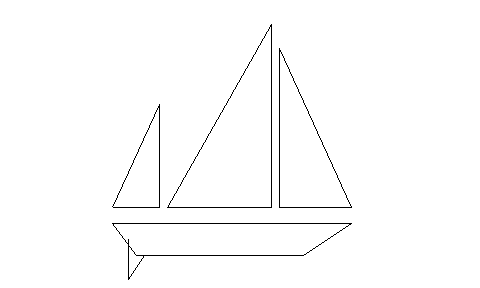
|
|
Schooner A vessel with two or more masts. The larger mast is located in the back.
|
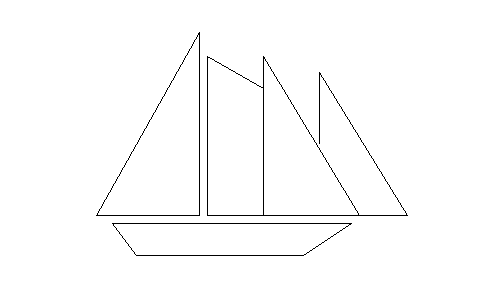
|
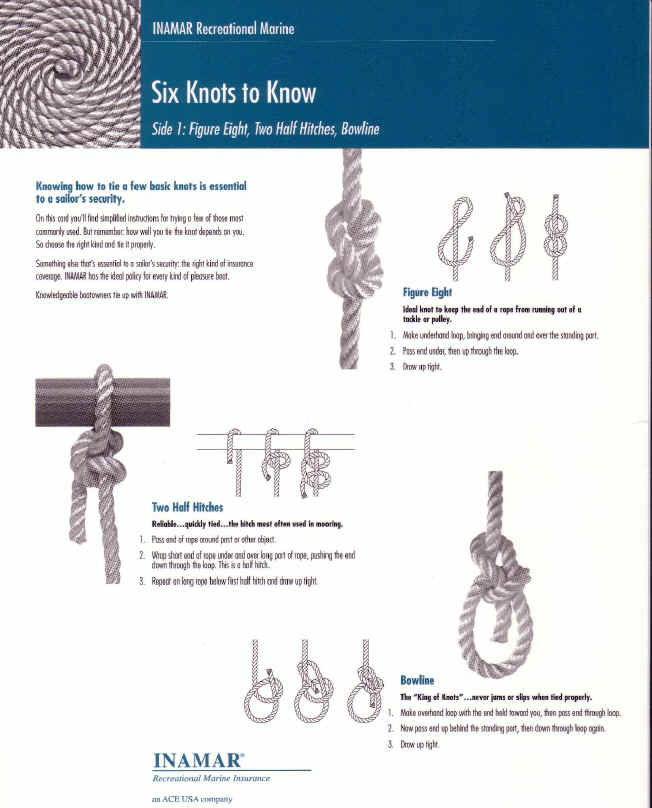
INAMAR Recreational Marine Insurance (Now CHUBB)
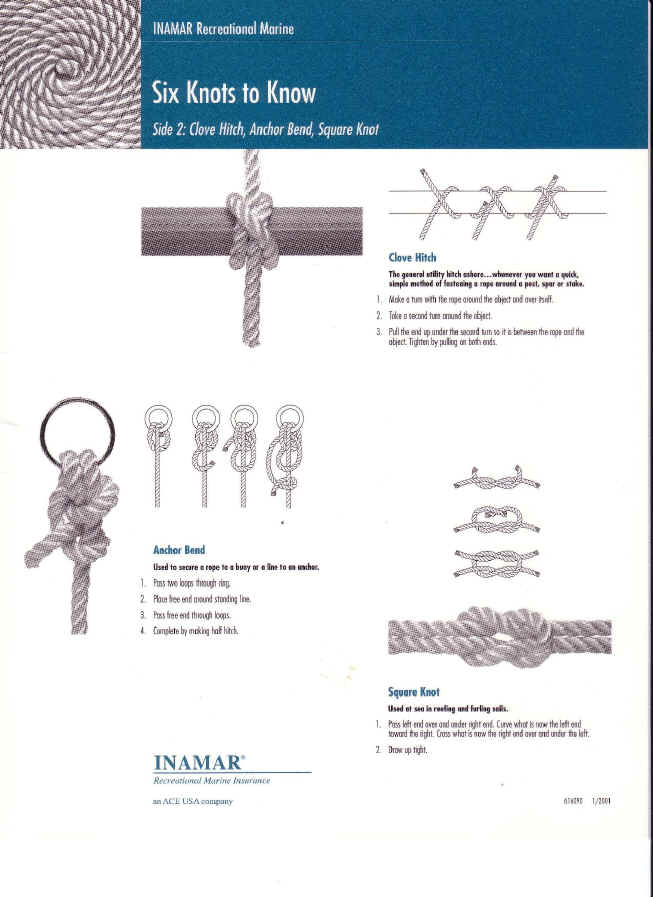
INAMAR Recreational Marine Insurance (Now CHUBB)
|
1 fathom |
6 feet |
|
1 horsepower |
15 pounds of
thrust |
|
1 meter |
3.1 feet |
|
1 nautical mile |
1.15 statute mile |
|
1 nautical mile |
1 minute latitude
(1/60 of a degree) |
|
1 nautical mile |
6,072 feet |
|
1 nautical mile |
2,024 yards |
|
1 nautical mile |
1,850.7 meters |
|
1 statute mile |
5,280 feet |
|
1 statute mile |
1,760 yards |
|
1/6th nautical
mile |
1 second of
latitude |
|
60 nautical miles |
1° (degree)
latitude |
|
Abeam |
Off the side of (at right angle to) the boat. |
|
Aft |
At or toward the stern of behind the boat. |
|
Alternator |
A device which generates electricity from an engine. |
|
Amidships |
Toward the center of the boat. |
|
Apparent wind |
The wind aboard a moving boat. |
|
ARA |
Armada of the
Republic of Argentine (Argentina) |
|
Astern |
Behind the stern of the boat. |
|
Athwartships |
Across the boat from side to side. |
|
Average speed |
5 – 6 knots for
most large keel boats |
|
Back |
To hold the clew of a sail out to windward. A counterclockwise change in wind direction. |
|
Back & fill |
Using forward and reverse gears, as well as prop walk and rudder angles, to turn a boat in close quarters. |
|
Backing wind |
Wind shift to the
left |
|
Backstay |
The standing rigging running from the stern to the top of the mast. |
|
Ballast |
Weight in the keel that provides stability. |
|
Ballast ratio
(should be at least 40%) |
Weight of ballast
divided by gross weight of the boat |
|
Barometer |
A weather forecasting instrument that measures air pressure. |
|
Batten |
A thin slat that slides into a pocket in the leech of a sail, helping it hold its shape. |
|
Battery starting
power |
100% at 80°, 65%
at 32°, 40% at 0° |
|
Battery switch |
The main electrical cutoff switch. |
|
Beam |
The width of a boat at its widest point. |
|
Beam reach |
Sailing in a direction at approximately 90 degrees to the wind. |
|
Bear away |
To fall off, head away from the wind |
|
Bearing |
A course sailed upwind. |
|
Below |
The area of a boat beneath the deck. |
|
Bend |
To attach a sail to a spar or a headstay, or to attach a line to a sail. |
|
Berth |
The area in which you park your boat. The area in which you sleep on a boat. |
|
Bight |
A loop in a line. |
|
Bilge |
The lowest part of the boat's interior where water on board will collect. |
|
Bimini |
A sum awning used to cover the cockpit area. |
|
Bitter end |
The end of a line. |
|
Black Squall |
Dark and
threatening. Usually accompanied by rain. |
|
Blanket |
To use a sail or object to block the wind from filling a sail. |
|
Block |
A pulley on a boat. |
|
Boat hook |
A pole with a hook used for grabbing hold of a mooring or an object in the water. |
|
Bolt rope |
The rope sewn into the foot and luff of some mainsails and jibs by which they are attached to the boat. |
|
Boom vang |
A block and tackle system which pulls the boom down to assist sail control. |
|
Bottom Paint
Components |
Toxicant, Vehicle
or binder, Thinners, & Pigment |
|
Bow |
The forward part of the boat. |
|
Bow line |
A line running from the bow of the boat to the dock or mooring. |
|
Bowline |
A knot designed to make a loop that will not slip and can be easily untied. |
|
Breast line |
A short dock line leading off the beam of the boat directly to a dock. |
|
Broach |
An uncontrolled rounding, usually from a downwind point of sail. |
|
Broad reach |
Sailing in a direction with the wind at the rear corner of the boat (approximately 135 degrees from the bow). |
|
Bulkhead |
A wall that runs athwartships on a boat. |
|
By the lee |
Sailing on a run with the wind coming over the same side of the boat as the boom. |
|
Cabin |
The interior of a boat. |
|
Can |
An odd-numbered, green buoy. |
|
Capacity |
(Boat length x
boat width) divided by 15 |
|
Careening |
Running a boat
onto a sloping shore at high tide to expose the bottom for
maintenance at low tide. |
|
Cast-off |
To release a line. |
|
Chainplate |
Strong metal plate which connect the shrouds to the boat. |
|
Channel |
A path in the water marked by buoys in which the water is deep enough to sail. |
|
Chart |
A nautical map. |
|
Charter |
To rent a boat. |
|
Chock |
A guide mounted on the deck through which docklines and anchor rodes run. |
|
Chop |
Rough, short, steep waves. |
|
Clew |
The lower, aft corner of a sail. |
|
Close reach |
Sailing in a direction with the wind forward of the beam but aft of the closed-hauled position. |
|
Close-hauled |
The point of sail closest to the wind. |
|
Cockpit |
The lower area in which the steering controls and sail controls are located. |
|
Coil |
To neatly loop a line for storage. |
|
Come about |
See "tack." |
|
Companionway |
The steps leading from the cockpit to the cabin below. |
|
Compass protractor |
A plotting instrument oriented to latitude-longitude lines. |
|
Compass rose |
The circle on a chart which indicates the direction of true north and magnetic north. |
|
Converter |
A device to change AC current to DC. |
|
Cringle |
A ring sewn into the sail through which a line can be passed. |
|
Current |
The horizontal movement of water caused by tides, wind, and other forces. |
|
Dinghy |
A small sailboat, rowboat, or small boat with an outboard. |
|
Displacement |
Weight of a boat (i.e. the amount of water it displaces). |
|
Distance to a
storm (nautical miles) |
(# of seconds
between lightning & thunder) / 5.5 |
|
Distance to a
storm (statue miles) |
(# of seconds
between lightning & thunder) / 5 |
|
Divider |
Instrument used for measuring distances or coordinates on a chart. |
|
Dock |
Wooden structure where a boat can be tied up. The act of bringing a boat along side a structure. |
|
Docking |
Floating a vessel
into dry-dock and pumping out the water to expose the bottom for
maintenance. |
|
Dockline |
A line used to secure the boat to the dock. |
|
Downwind |
A direction away from the direction of the wind. |
|
Draft |
The depth of a boat below the water's surface |
|
Ebb |
An outgoing tide |
|
EPIRB |
An emergency position indicating radio beacon. |
|
Fathom |
A measurement of depth of the water. One fathom equals six feet. |
|
Fender |
A rubber bumper used to protect a boat. |
|
FGS |
Federal German
Ship (Germany) |
|
Fitting |
A piece of natural hardware. |
|
Float plan |
An itinerary of your intended sailing trip left with a responsible party onshore. |
|
Float switch |
A device that turns on a bilge pump when water inside reaches a certain level. |
|
Flood |
Incoming tide. |
|
Flotilla |
A group of boats on an organized cruise. |
|
Foot |
Bottom edge of a sail. |
|
Fore |
Foreword |
|
Foresail |
A jib or a genoa. |
|
Forestay |
The standing rigging running from the bow to the mast to which the jib is attached. |
|
Forward |
Toward the bow. |
|
Fouled |
Tangled. |
|
Furl |
To fold or roll up a sail. |
|
FV |
Fishing Vessel
(non-military merchant ship) |
|
Genoa |
A large jib whose clew extends aft of the mast. |
|
Gimbal |
A system that keeps items horizontal as the boat heels. |
|
Grommet |
A reinforcing metal ring in a sail. |
|
Ground tackle |
The anchor and rode (chain and line). |
|
Gunwale |
The edge of the deck where it meets the topsides. |
|
Halyard |
A line used to hoist or lower a sail. |
|
Hank |
A snap hook that attaches the luff of a jib to the forestay. |
|
Hard over |
To turn the tiller or wheel as far as possible in one direction. |
|
Hard-a-lee |
Command given to the crew to begin a tack. |
|
Hatch |
A large covered opening on a boat. |
|
Haul in |
To tighten a line. |
|
Hauling |
Maneuvering a
boat into a wheeled cradle running on an underwater railway and
winching her ashore for maintenance. |
|
Head |
The top corner of a sail. The bathroom on a boat. The toilet on a boat. |
|
Heading |
The direction of the boat expressed in compass degrees. |
|
Heave-to |
To hold a position in the water in which the force of the wind and the rudder counter one another. |
|
Heaving Down |
Attaching tackles
to the masthead and heaving a boat onto its side to expose the
bottom for maintenance. |
|
HMAS |
Her Majesty’s
Australian Ship (Australia) |
|
HMCS |
Her Majesty’s
Canadian Ship (Canada) |
|
HMNZS |
Her Majesty’s New
Zealand Ship (New Zealand) |
|
HMS |
Her Majesty’s
Ship (UK & Saudi Arabia) |
|
Holding ground |
The bottom ground in an anchorage used to hold the anchor. |
|
Holding tank |
A tank that holds and stores human waste rather than pumping it overboard. |
|
Hove-to |
A boat that has successfully completed the process of heaving-to and is holding its position. |
|
Hull speed |
Theoretical maximum speed of a sailboat determined by the length of its waterline. |
|
In irons |
A boat that is head-to-wind, making no forward headway. |
|
INS |
Indian Naval Ship
(India) & Israeli Naval Ship (Israel) |
|
Inverter |
A device to change DC current to AC. |
|
Isobar |
A line joining places of equal air pressure as depicted on a weather map. |
|
Jacklines |
Study lines affixed to the sides of the boat to which the crew and attach their safety harnesses. |
|
Jib |
The small forward sail attached to the forestay. |
|
Jibe |
To change direction of a boat by steering the stern through the wind. |
|
Jury rig |
An improvised, temporary repair. |
|
Land breeze |
A wind blowing over land and out to sea. |
|
Lash |
To tie down. |
|
Lay |
To sail a course that will clear an obstacle without tacking. |
|
Lazarette |
A storage compartment built into the deck. |
|
Lead |
To pass a line through a fitting or block. |
|
Lee helm |
The boat's tendency to turn away from the wind. |
|
Lee shore |
Land which is on the leeward side of the boat. |
|
Leech |
The after edge of a sail. |
|
Leeward |
The direction away form the wind (where the wind is blowing to). |
|
Leeward side |
Side of the boat or said that is away from the wind. |
|
Leeway |
5° – 10° for most
large keel boats |
|
Leeway |
Sideways slippage of a boat in a direction away from the wind. |
|
Line |
A nautical rope. |
|
Luff |
The forward edge of a sail. The fluttering of a sail caused by aiming too close to the wind. |
|
Magnetic |
In reference to magnetic north rather than true north. |
|
Mast step |
The structure at the bottom of the mast. |
|
Masthead |
Top of the mast. |
|
Masthead fly |
A wind direction indicator at the top of the mast. |
|
Maximum speed |
1.34 x square
root of the length of the waterline |
|
Mayday |
The internationally recognized distress signal for a life-threatening emergency. |
|
Moonrise |
40 minutes later
than the previous night |
|
Mooring |
A permanently anchored ball or buoy to which a boat can be tied. |
|
MS |
Motor Ship
(non-military merchant ship) |
|
MSD |
Marine sanitation device - includes toilet, holding tank and connecting lines and valves. |
|
Nautical mile |
A distance of 6076 feet, equaling one minute of the earth's latitude. |
|
Navigation rules |
Laws established to prevent collisions on the water. |
|
Net tonnage |
Gross
tonnage--the total internal volume--minus all spaces not available
for carrying passengers and cargo |
|
No-go zone |
Area in the wind where a boat cannot produce power to sail. |
|
Nun |
A red, even numbered buoy. Nuns are usually paired with cans. |
|
Offshore |
Away from or out of sight of land. |
|
Offshore wind |
Wind blowing away from the land. |
|
Outboard |
A portable motor mounted on the transom. |
|
Outhaul |
The controlling line attached to the clew of a mainsail used to tension the foot of the sail. |
|
Overpowered |
A boat that is heeling too far because it has too much sail for wind conditions. |
|
Overtaking |
A boat that is catching up to another boat and about to pass it. |
|
Painter |
The line attached to the bow of a dinghy. |
|
Pan-pan |
The internationally recognized distress signal for an urgent but not life threatening situation. |
|
Parallel rulers |
Two rulers linked and held parallel by hinges used to plot a course. |
|
Pay out |
To ease out a line. |
|
PFD |
Abbreviation for personal floatation device (i.e. a life jacket). |
|
Piling |
A vertical timber or log driven into the sea bottom to support docks or form a breakwater. |
|
Plot |
Apply calculations to chart a position or course. |
|
Point |
To steer close to the wind. |
|
Points of sail |
Boat directions in relation to the wind. |
|
Port |
Left side of a
vessel facing forward. (Adopted by general order in 1846 by US Navy
rather than “larboard” which could be confused with “starboard.”) |
|
Port |
The left side of a boat when facing forward. A harbor. A window in a cabin on a boat. |
|
Port tack |
Sailing on any point of sail with the main boom on the starboard side of the boat. |
|
Prevailing wind |
Typical or consistent wind conditions. |
|
Propane |
A cooking fuel. |
|
Pulpit |
The stainless steel guardrail at the bow and stern of some boats. |
|
Quarter |
Sides of the boat near the stern. |
|
Quarter berth |
A bunk located under the cockpit. |
|
Radar reflector |
An object with lots of faces at sharp angles that can be spotted by other vessels radar scopes. |
|
Rake |
The angle of the mast. |
|
Range |
The alignment of two objects that indicates the middle of a channel. |
|
Raw water |
The fresh or salt water entering the boat. |
|
Reach |
One of several point of sail across the wind. |
|
Reef |
To reduce the size of a sail. |
|
Reefing line |
A line used to reduce sail by pulling the lower portion of the sail to the boom. |
|
Rhumb line |
A straight course between two points. |
|
Rig |
The design of a boat's mast, standing rigging, and sail plan. To prepare a boat for sailing. |
|
Rigging |
The wires and lines used to support and control the sails. |
|
Right-of-way |
The right of the stand-on vessel to hold its course. |
|
Rode |
Line and chain attached from the boat to the anchor. |
|
Roller furling |
A mechanical system to roll up a headsail (jib) around the headstay. |
|
Round up |
When a boat turns toward the wind, sometimes abruptly and with a great deal of heel. |
|
Rudder |
The underwater fin controlled by the wheel or tiller that deflects water and steers the boat. |
|
Run |
Sailing with the wind coming from behind the boat. |
|
Running rigging |
Line and hardware used to control the sails. |
|
Sail ties |
Pieces of line or webbing used to tie the mainsail to the boom when reefing or storing the sail. |
|
Scope |
The ratio of the amount of anchor rode deployed to the distance from the bow of the boat to the bottom. |
|
Scull |
To propel the boat by swinging the rudder back and forth like a fish tail. |
|
Scupper |
Cockpit or deck drain. |
|
Sea breeze |
A wind that blows over the sea and onto the land. |
|
Seacock |
A valve which opens and closes a hole through the hull of a boat. |
|
Secure |
Make safe or cleat. |
|
Securite |
An internationally recognized signal to warn others of a dangerous situation. |
|
Set |
The direction of a current. To trim the sails. |
|
Shackle |
A metal fitting at the end of a line used to attach the line to a sail or other fitting. |
|
Shake out |
To remove a reef and restore the full sail. |
|
Sheave |
A rotating wheel inside a block or fitting. |
|
Sheet |
The line which is used to control the sail by easing it out or trimming it in. |
|
Shoal |
Shallow water that may be dangerous. |
|
Shroud |
Standing rigging at the side of the mast. |
|
Skeg |
A vertical fin in front of the rudder. |
|
Skipper |
The person in charge of the boat. |
|
Slab reefing (jiffy reefing) |
Lowering and tying off the lower portion of a sail in order to reduce sail area. |
|
Slip |
See "berth." |
|
Snub |
To hold a line under tension by wrapping it on a winch or cleat. |
|
Sole |
The floor in a cockpit or cabin. |
|
Solenoid switch |
An electrical switch which shuts off the flow of propane. |
|
Spar |
A pole used to attach a sail on a boat (e.g. mast, boom, gaff). |
|
Spinnaker |
A larger billowing headsail used when sailing downwind. |
|
Splice |
Joining tow lines together by interweaving their stands. |
|
Spreader |
A support strut extending athwartships from the mast used to support the mast and guide the shrouds to the chainplates. |
|
Spring line |
A dockline running forward or aft from the boat to the dock to keep the boat from moving forward or aft. |
|
Squall |
Sudden, violent
gust of wind |
|
Squall |
A short, intense storm with little warning. |
|
SS |
Steam Ship
(non-military merchant ship) |
|
Stanchions |
Stainless steel supports a the edge of the deck which hold the lifelines. |
|
Standing rigging |
The permanent rigging (usually wire) of a boat that includes the forestay, backstay, and shrouds. |
|
Stand-on vessel |
Vessel or boat with the right-of-way. |
|
Starboard |
Right side of a
vessel facing forward. |
|
Starboard |
The right side of the boat facing forward. |
|
Starboard tack |
Sailing on any point of sail with the main boom on the port side of the boat. |
|
Stay |
A wire support for a mast, part of the standing rigging. |
|
Staysail |
A second small "inner jib" attached between the bow and the mast of a cutter. |
|
Steerage or Steeageway |
The minimums amount of speed needed to control direction of the vessel. |
|
Stem |
The forward tip of the bow. |
|
Stern |
The aft part of the boat. |
|
Stuffing box |
The opening in the hull where the propeller shaft exits. |
|
Sump |
A cavity or tank in the bilge to collect water. |
|
Tack |
A course on which the wind comes over one side of the boat (e.g. port tack). To change direction by turning the bow through the wind. The lower forward corner of a sail. |
|
Tackle |
A sequence of blocks and line that provides a mechanical advantage. |
|
Tail |
To hold and pull a line from behind a winch. |
|
Telltales |
Pieces of yarn or sailcloth attached to sails that indicate when the sail is properly trimmed. |
|
Tether |
A length of line connecting safety harness to padeye or jackline. |
|
Throttle |
A device for controlling the engine's revolutions per minute (RPM). |
|
Tide |
The rise and fall of water level due to the gravitational pull of the sun and moon. |
|
Toe rail |
A short aluminum or wooden rail around the outer edges of the deck. |
|
Topping lift |
A line used to hold the boom up when the mainsail is lowered or stowed. |
|
Topsides |
The side of the boat between the water line and the deck. |
|
Transom |
The vertical surface of the stern. |
|
Traveler |
A track or bridle that controls sideways movement of the mainsail. |
|
Trim |
To pull on a sheet. How a sail is set relative to the wind. |
|
True wind |
The actual speed and direction of the wind when standing still. |
|
Tune |
To adjust a boat's standing rigging. |
|
Turnbuckle |
A mechanical fitting attached to the lower ends of stays used to adjust the standing rigging. |
|
Underway |
To be moving under sail or engine. |
|
Upwind |
Toward the direction of the wind. |
|
USCGC |
U.S. Coast Guard
Cutter |
|
USNS |
United States
Naval Ship (Military Sealift Command) |
|
USS |
United States
Ship “in service” |
|
V-berth |
A bunk in the bow of the boat that narrows as it goes forward. |
|
Veer |
A clockwise change of wind direction. |
|
Veering wind |
Wind shift to the right |
|
Vessel |
Any sailboat, powerboat, or ship. |
|
VHF |
Abbreviation for very high frequency, a two-way radio commonly used in boating. |
|
Wake |
Waves caused by a boat moving through the water. |
|
Waterline |
The horizontal line on the hull of a boat where the water surface should be. |
|
Weather helm |
The boat's tendency to head up toward the wind. Occurs when a sailboat is overpowered or the sail trim is out of balance (jib trim too loose and/or mainsail trim too tight. |
|
Weather side |
Same as "windward side." |
|
Whip |
To bind together the stands at the end of a line. |
|
Whisker pole |
A temporary pole used to hold the jib out and keep it full when sailing downwind. |
|
White Squall |
Squall announced
only by whitecaps, a whitish haze in the air, and a rushing sound. |
|
Winch |
A drum with a handle offering mechanical advantage used to trim sheets or raise sails. |
|
Windage |
The amount of surface area on a boat that is presented to the wind. |
|
Windlass |
A mechanical device, usually electric, secured to the bow of the boat or in the anchor locker that is used to raise and lower the anchor. |
|
Windward |
Toward the wind. |
|
Windward side |
The side of a boat or sail closest to the wind. |
|
Wing-and-wing |
Sailing downwind with the jib set on the opposite side of the mainsail. |
|
Working sails |
The mainsail and standard jib. |
|
Working sheet. |
The leeward jib sheet that is tensioned by the wind on the sail. |
|
Y-valve |
A double valve used to redirect water flow. |
![]()
The Last Priest available at TheLastPriest.com